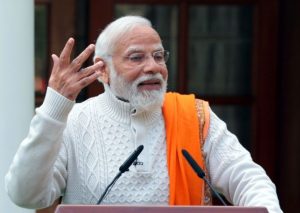Biography of Narendra Damodardas Modi ( PM of India )
Narendra DamodarDas Modi is an Indian politician who has served the 14th Prime Minister of India since 26 May 2014.
About :
Age-73 years ( 17 September 1950 ) , Vadnagar (Gujrat) ,
Mother- Heeraben Modi ( 1920-2022)
Father- Late Damodardas Mulchand Modi
Spouse – Jashodaben Modi ,
Education – Gujrat University ( 1983 ) Schools of open Learning, University of Delhi ( 1978)
Awards- Order of Distinguished Rule of Izzudin(2019), Legion of Honor(2023), Seoul peace prize(2018), CNN-IBN Indian of the year (2015)
Party- Bharatiya Janata Party (BJP)
 Narendra Modi was the chief minister of Gujrat from 2001 to 2014 and is the member of Parliament ( MP ) for Varanasi. After that he became the 14th Prime minister of India since 2014. He is a member of Bhartiya Janata party ( BJP ). Modi was born and raised in Vadnagar in northeastern Gujrat, where he completed his secondary education. At the age of 18 he was married to Smt. Jasodaben Modi , whom he abandoned soon after. Modi became a full-time worker for the RSS ( Rastriya Swayamsevak Sangh) in Gujrat in 1971. The RSS assigned him to the BJP in 1985 and he rose through the party hierarchy , becoming general secretary in 1998. Modi appointed as Chief minister of Gujrat in 2001. Since 2014 , he is the current Prime Minister of India and prior to it, he had aerved as the Chief minister of Gujrat state from 2001 to 2014.
Narendra Modi was the chief minister of Gujrat from 2001 to 2014 and is the member of Parliament ( MP ) for Varanasi. After that he became the 14th Prime minister of India since 2014. He is a member of Bhartiya Janata party ( BJP ). Modi was born and raised in Vadnagar in northeastern Gujrat, where he completed his secondary education. At the age of 18 he was married to Smt. Jasodaben Modi , whom he abandoned soon after. Modi became a full-time worker for the RSS ( Rastriya Swayamsevak Sangh) in Gujrat in 1971. The RSS assigned him to the BJP in 1985 and he rose through the party hierarchy , becoming general secretary in 1998. Modi appointed as Chief minister of Gujrat in 2001. Since 2014 , he is the current Prime Minister of India and prior to it, he had aerved as the Chief minister of Gujrat state from 2001 to 2014.
In Lok Sabha Election 2019, Narendra Modi has won by around 4.79 lac votes against Shalini Yadav , Samajwadi Party. His Swearing-Ceremony is organized on 30th May,2019 for the second term as a prime minister of India and in 2024 he again became the boldest and strongest Prime Minister of India.
Political career of Modi:
- The timeline of Narendra Modi’s political career leading up to his tenure as Prime Minister of India is as follows:
- 1987: Joined Bharatiya Janata Party (BJP).
- 1988: Appointed as the General Secretary of BJP’s Gujarat unit.
- 1995: Recognized for his strategic acumen during party campaigns; appointed as Secretary of BJP’s national unit.
- 1998: BJP won the Gujarat assembly elections. Two key events contributing to BJP’s success were:
- Somnath to Ayodhya Rath Yatra led by L.K. Advani.
- Kanyakumari to Kashmir Ekta Yatra led by Murli Manohar Joshi.
- 1998-2001: Served as General Secretary of BJP.
- October 2001: Sworn in as the Chief Minister of Gujarat for the first time.
- 2002: Re-elected as Chief Minister after defeating Oza Yatinbhai Narendrakumar of INC.
- 2007-2012: Third term as Chief Minister of Gujarat.
- 2012: Elected for a fourth term as Chief Minister after defeating Shweta Sanjiv Bhatt. However, he later resigned from the assembly in 2014.
- 2014: Contested the Lok Sabha elections and won with a significant margin.
- May 26, 2014: Sworn in as the 15th Prime Minister of India.
Narendra Modi’s rise within the BJP from a state-level leader to the Prime Minister of India reflects his political acumen, strategic leadership, and ability to connect with voters on a national scale. His tenure has been marked by several ambitious initiatives aimed at transforming India’s economy, infrastructure, and global stature.
Don’t dream to be something but rather dream to do something great!’
‘-Narendra Damodardas modi
